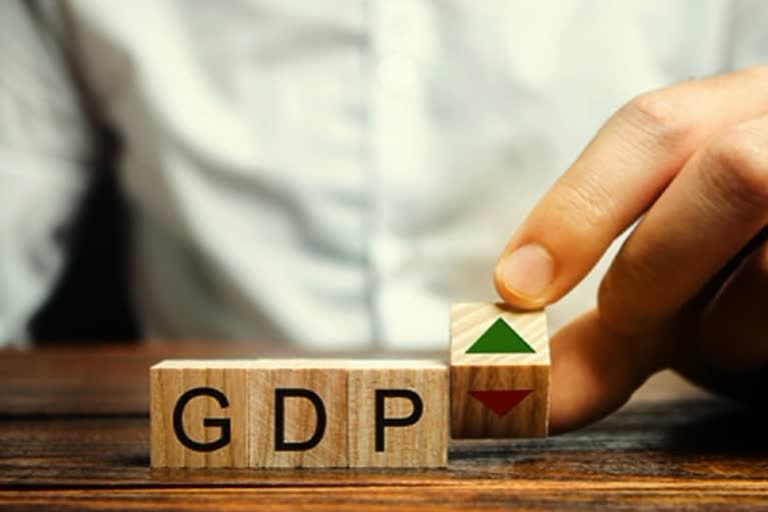New Delhi: India’s gross domestic product expanded by 6.3% in July-September this year in comparison with the GDP growth during the same period last year.
It means that Real GDP or GDP at the constant prices during this period was at around Rs 38.17 lakh crore as against the production of goods and supply of services worth Rs 35.89 lakh crore during the same period last year, an increase of Rs 2.8 lakh crore or 6.3% year-on-year basis.
It is a decline of nearly two percentage points in comparison with the real GDP growth witnessed during the same period last year as the real GDP in the second quarter of the last fiscal had registered an 8.4 percent year-on-year growth which was mainly attributed to the low base of the preceding year when the economic activity was badly hit by nationwide lockdowns.
Similarly, the nominal GDP, or the GDP at the current prices, has seen double-digit growth of over 16% during the same period as it grew from Rs 56.2 lakh crore in July-September last year to Rs 65.31 lakh crore in the July-September period this year.
But the nominal GDP growth rate has been less impressive in comparison with the growth rate during the same period of last year when it had registered a growth of 19% in comparison with the same period of the preceding year.
If one looks at India’s growth during the first six months of this financial year (April-September 2022) then the real GDP has grown by 9.7 percent, from Rs 68.36 lakh crore in the first half of 2021-22 to Rs 75.02 lakh crore during April-September this year.
GDP at Current Prices in the first half of 2022-23 has estimated at Rs 130.26 lakh crore as against Rs 107.47 lakh crores during the corresponding period of previous year, showing a growth of 21.2 percent.
As expected, the half-yearly GDP growth rate has slowed down in comparison with the growth rates witnessed during the same period last year. For example, half yearly real GDP growth rate slowed down to 9.7% as against the growth rate of 13.7% witnessed during the same period last year.
Similarly, the half yearly nominal GDP growth rate also declined from a high of 25% witnessed during the April-September last year to 21.2% in the July-September this year.
It was widely estimated that India’s GDP growth rate would come down significantly this year in comparison with the same period last year as a high year-on-year growth recorded during the last financial year was mainly attributed to low base effect of the first Covid year when the entire country was under severe lockdown for the first six months, from April to September 2020.
Impact of high inflation, Russia-Ukraine war
The slowdown in the country’s GDP is attributed to persistently high inflation triggered by the high energy and food prices due to ongoing Russia-Ukraine war that forced the Reserve Bank to increase the benchmark lending rate, known as repo rate that squeezed the money supply in the market and impacted the growth.
In its September monetary policy announcement, the Reserve Bank of India had estimated the real GDP growth for the current financial year to be at around 7 per cent while it had pegged the half-yearly real GDP growth in the second quarter to be at 6.3 per cent, which has been estimated to further slow down to just 4.6 per cent in the second and third quarter of this fiscal.
While the Reserve Bank estimated GDP growth rate in the second quarter to be in the range of 6.1 per cent to 6.3 per cent, other rating agencies pegged the gross domestic product (GDP) growth rate between 5.8 per cent to 6.5 per cent.
These quarterly estimates of gross national domestic production, which tries to capture the economic activity on the basis of the value of the goods produced and services supplied in a given period, are based on several high frequency indicators of economic activity both in the government and private sector.
For example, the sector-wise estimates have been compiled using high frequency economic indicators such as Index of Industrial Production (IIP), financial performance of listed companies in the private sector as their quarterly financial results are taken into consideration while calculating GDP growth.
In addition to these two data sets, the government also uses data regarding the production and consumption of cement and steel, net tonne kilometres and passenger kilometres for railways, passenger and cargo traffic handled by civil aviation, cargo traffic handled at major sea ports, sale of commercial vehicles, bank deposits and credits.
In the agriculture sector, the statisticians use the first advance estimates of crop production for 2022-23, production estimates of major livestock products for summer season for 2022-23, fish production and finally the accounts of Union government and state governments are factored in while estimating the GDP growth.



